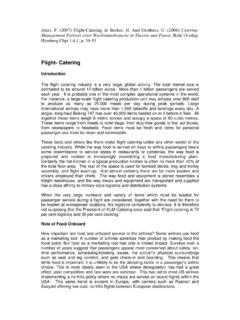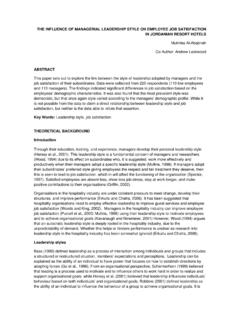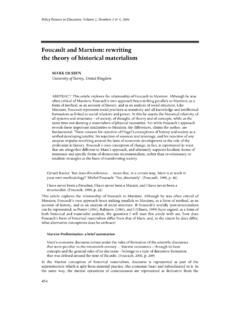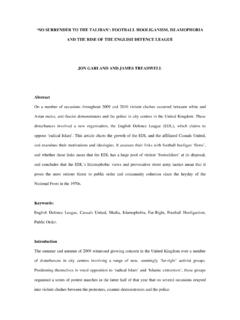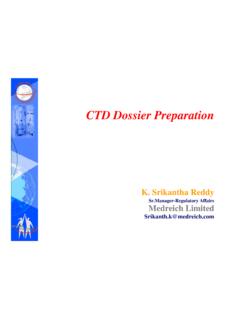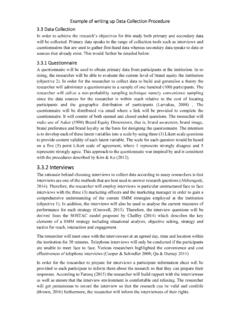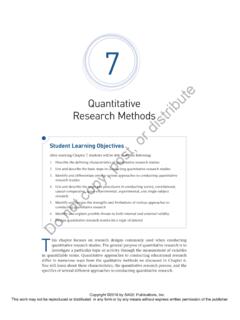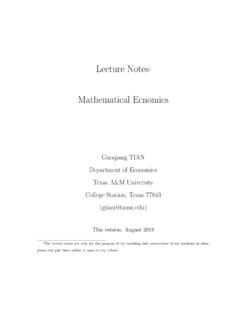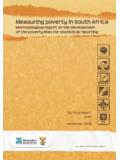Transcription of Triangulation and Mixed Methods Designs: Data …
1 Published as Journal of Mixed Methods Research published online 30 March 2012. DOI: Triangulation and Mixed Methods Designs: data Integration with New Research Technologies Nigel G. fielding, University of Surrey. Abstract data integration is a crucial element in Mixed Methods analysis and conceptualization. It has three principal purposes: illustration, convergent validation ( Triangulation ), and the development of analytic density or richness.'' This article discusses such applications in relation to new technologies for social research, looking at three innovative forms of data integration that rely on computational support: (a) the integration of geo-referencing technologies with qualitative software, (b) the integration of multistream visual data in Mixed Methods research, and (c) the integration of data from qualitative and quantitative Methods .
2 Combining different Methods and kinds of data in the empirical study of social phenomena goes back to the beginnings of social science (see Hesse-Biber, 2010a, for the historical lineage of the Triangulation concept and Plano Clark, 2010, for an account of the rise of Mixed Methods in government funded research). Mixed Methods potentially offer depth of qualitative understanding with the reach of quantitative techniques. Initially, it was the more quantitative researchers such as Paul Lazarsfeld who practiced Mixed Methods (Jahoda, Lazarsfeld, & Zeisl, 1976), but following Campbell's papers on Triangulation '' as a means of convergent validation (Campbell & Fiske, 1959). and the emergence of grounded theory (Glaser & Strauss, 1967), whose constant comparative method'' involves comparing data from different sources, the Triangulation metaphor also became established in qualitative research.
3 Ivankova and Kawamura (2010) offer a comprehensive and extensive bibliometric survey of contemporary Mixed Methods practice. On the basis of searches of five databases (PubMed, ERIC, PsychInfo, Academic OneFile, Academic Search Premier) and two journals (Journal of Mixed Methods Research, International Journal of Multiple Research Approaches), Ivankova and Kawamura found a consistent growth in Mixed Methods research since 2000. Numbers rose increasingly sharply from the year 2000 (N = 10) to 2008 (N = 243). Some 689. studies were classed as full Mixed Methods research designs after applying the restrictive requirement that each must have both quantitative and qualitative elements (there is no logical reason why a study combining purely qualitative or purely quantitative Methods could not be regarded as Mixed Methods ''; see Denzin, 1970).
4 An interesting (and appealing) view is that the use of Mixed Methods provides a rationale for hypotheses/theories/guiding assumptions to compete and provide alternatives'' (Niaz, 2008, p. 64). This perspective stands in tension with the more formulaic renderings of Mixed Methods . Declining emphasis on creativity, inventiveness, and risk taking is often a mark of methodological innovations as they move to the mainstream. Although Ivankova and Kawamura (2010) cite a stream of how to''. literature on the application of Mixed Methods research designs, the actual integration of data was generally neglected in this work a problem that Plano Clark, Huddleston-Casas, Churchill, Green, and Garrett (2008) declare is a general one. Since the presumable point of mixing Methods is to see the analytic implications of linking data derived from different Methods rather than have findings from different Methods talk past each other,'' the neglect of data integration is a troubling matter on which the present article focuses.
5 Against the context of mushrooming growth, it is timely to remind ourselves that effective data integration requires a well-considered approach that knows when to synthesize some findings (because they are equivalent and commensurate) and when to respect and investigate contradictory findings (because the contradiction reflects epistemologically based differences that cannot be resolved empirically, only conceptually). Bandwagons bring their own rationale;Christ (2009) is among several sources arguing that the quantitative elements of a design may be prominent less for reasons of fitness-for-purpose than to address the expectations of those who review grants and commission policy research. Such work tends toward a postpositivist frame that warrants mixing Methods as a means to discover social facts.
6 '' Its search for the single valid finding'' acts against the truly radical potential that Mixed Methods research has to build prismatic understandings of social phenomena and to promote the analytic density from which iterative social knowledge can be built (Fielding, 2009). In case this seems starry-eyed or a recipe for theoretical waffle, consider Hesse-Biber's (2010b) summary of reasons for giving the qualitative element prominence in the qualitative quantitative Mixed Methods design . She cites the resulting ability to test representativeness/ generalization, to better locate target populations or define them for in-depth study, to achieve demonstrable reliability and validity, to address inconsistent results, and to deepen our understanding of the research problem.
7 In recent years, arguments have been put forward advocating Mixed Methods as a means of beneficial social transformation and of promoting greater social justice (Mertens, 2010). As an element of a Mixed method design , qualitative Methods are particularly open to such applications because these are Methods that rely on sustained fieldwork engagement and get close to participants in a way that one-shot surveys or the secondary analysis of administrative data sets do not. However, the really compelling argument for Mixed Methods designs remains their benefits for sophisticated analytical conceptualization. As Maxwell (2010) argues, the real quantitative/qualitative distinction is not between number and text but between understanding the world by a theory of variance featuring variables and correlations and understanding the world by a theory of process in terms of events and interactions.
8 Put that way, it is clear that both are essential. Rather than mixing because there is something intrinsic or distinctive about quantitative data or qualitative data , we mix so as to integrate the two fundamental ways of thinking about social phenomena. We quantify qualitative data for integration with quantitative data to answer research questions or test hypotheses addressing relationships between independent (or explanatory or predictor) variable(s) and dependent (or response or outcome) variables'' (Sandelowski, Voils, & Knafl, 2009, p. 211), and we quantify recurrent patterns in qualitative data to allow analysts to discern and to show regularities or peculiarities in qualitative data they might not otherwise see .. or to determine that a pattern or idiosyncrasy they thought was there is not'' (Sandelowski et al.)
9 , p. 210). This considered synthesizing approach runs parallel to King, Keohane, and Verba's (1994) attempt to develop a unified approach to valid descriptive and causal inference by applying the standards of quantitative Methods to qualitative Methods , but Mixed Methods ambitiously transcends their approach by combination and conversion at the analytic stage. King et al. (1994) concede a limited role for qualitative Methods in situations where numerical measurement is either impossible or epistemologically dubious, shifting attention to research design and data collection rather than analysis. They seek to make qualitative work a better partner for quantitative work by tightening its attention to measurement error, incomplete information, omitted variables, estimating the certainty of conclusions, and so on.
10 Both King et al.'s (1994) efforts and the much larger Mixed Methods field are instances of the synthesizing project that periodically surfaces in social science. Synthesis is certainly worthwhile in the context of the seemingly banal findings of much social research, but more is needed than simply strapping together every available source of information. The point is that some combinations can illuminate some kinds of research questions in some empirical cases better than can mono Methods . Mixing Methods effectively requires a profound appreciation of the threats to validity inherent in the Methods being combined. For instance, Denzin (2010) pursues one of the inherent problems of convergent validation highlighted in Fielding and Fielding (1986), which is that the Triangulation logic must negotiate the fact that one cannot measure precisely the same thing twice.
